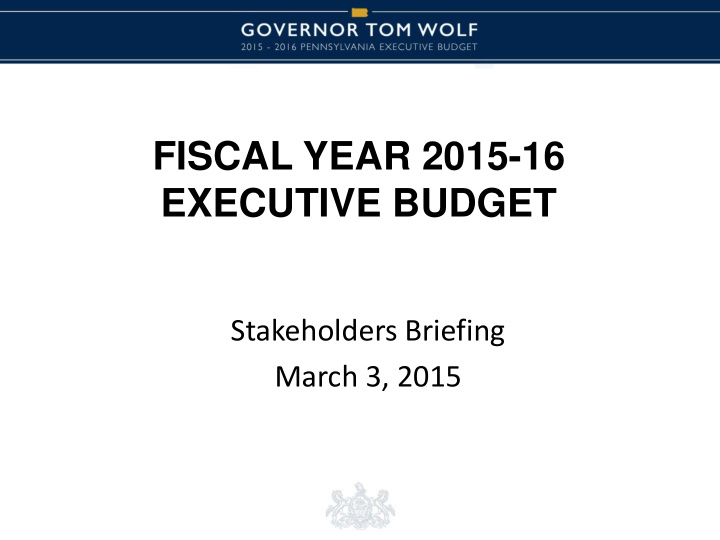



FISCAL YEAR 2015-16 EXECUTIVE BUDGET Stakeholders Briefing March 3, 2015
2015-16 BUDGET HIGHLIGHTS: OVERVIEW This budget rebuilds the middle class by investing in education to prepare students and workers for good-paying, 21 st -century jobs, ensures government uses taxpayer dollars effectively and efficiently, cuts corporate taxes and improves our business climate, significantly reduces school district property taxes, and decreases the government’s overall tax burden on hard -working, middle-class homeowners. Jobs that Pay Schools that Teach Government that Works 2
PENNSYLVANIA DEPARTMENT OF AGING Teresa Osborne Acting Secretary
SENIOR PLAN Governor Wolf is committed to increasing opportunities for seniors to age in place as well as to strengthen the homecare workforce. The actions announced are just the first step in rebalancing our long-term care system and increasing opportunities for homecare workers. The Senior Initiative includes steps to: – Expand Services for Older Pennsylvanians and Reduce Long-Term Care Costs – Phase in Medicaid Managed Long Term Care – Improve Long Term Living Waiver Enrollment and Service Plan Development Process – Improve Home Modifications Selective Contracting – Implement Online Homecare Registry – Ensure Seniors have Choices about Where to Receive Care This package is designed to provide choices for seniors, efficiencies in home- and community-based care delivery, and protections so that seniors receive the high quality level of care that they seek in their homes.
PENNSYLVANIA DEMOGRAPHICS • Pennsylvania’s population age 60 and over is projected to increase over the next 30 years: – 3.462 million in 2020 (26.2% of total PA population) • By 2020, more than one in four Pennsylvanians will be age 60 and older • Pennsylvania’s population age 85 and over is also expected to almost double over the next 30 years: – 300,000 in 2010 (2.4%) Source: Penn State Data Center – 610,000 in 2040 (4.3%)
PDA CONSTITUENTS • Profile of the PDA service recipient: – Females, over the age of 80 who are predominately widowed – Individuals of limited economic means but not actively receiving public assistance from Medicaid or general assistance through Department of Human Services – More likely to be minority than the total statewide percentage • Current PDA program demographic data: – More than 39% of all consumers receiving services are over the age of 80 and 24% of these individuals are over the age of 85. – At least 27% of the individuals receiving services in PDA programs over 60 and 20% of the individuals over the age of 85 are minority populations (higher than the state average for this population). • Current program demographic data/gender: – Older women are, by far, the largest recipients of services by PDA at 67%. Older women make up 71% of the number of individuals receiving services over the age of 85. – For minorities, women make up approximately 64% of the population. For non- minorities, women comprise 66% of the population.
PDA FUNDING 2014-15 Available Budget 2015-16 Governor’s Budget Lottery Fund General Gov’t Operations $7,927 $8,708 PENNCARE $299,306 $305,190 $10,735 $16,135 Pre-Admission Assessment $12,103 $12,103 Caregiver Support $250 $250 Alzheimer's Outreach $155,000 $160,000 Pharmaceutical Assistance $2,000 $2,000 Grants to Senior Centers (in $1,000s)
GOVERNOR'S EXECUTIVE BUDGET 2015-16 STATE FUNDS General Government Operations, Pharmaceutical Assistance, Grants to Senior Center, 0.40% 1.73% 31.72% Alzheimer's Outreach, 0.05% PennCARE, 60.51% Pre-Admission Assessment, 3.20% Caregiver Support, 2.40%
Recommend
More recommend